Papers by Ancharida Akaracharanya
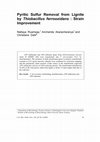
ATP sulfurylase and APS reductase genes from Allochromatium vinosum strain D (DSMZ 180) were tran... more ATP sulfurylase and APS reductase genes from Allochromatium vinosum strain D (DSMZ 180) were transformed into T. ferrooxidans Y4-3 by electroporation. The existence of both transformed genes in putative transformant resistant to 0.25 µg/ml mercuric chloride were confirmed by restriction mapping and the polymerase chain reaction. Crude extract of the transformant expressed ATP sulfurylase activity at 0.034 units/mg protein. The transformant desulfurized 43.49% of the total pyritic sulfur from lignite or about 3.8 times higher than that of the wild type. นาตยา รวมทรั พย อั ญชริ ดา อั ครจรั ลญา และ คริ สเตี ยน ดาล (2546) วารสารวิ จั ยวิ ทยาศาสตร จุ ฬาลงกรณ มหาวิ ทยาลั ย, 28(1) ถ ายโอนยี นประมวลรหั สเอที พี ซั ลฟู รี เลสและเอพี เอสรี ดั กเตสจาก Allochromatium vinosum strain D (DSMZ 180) เข าสู T. ferrooxidans Y4-3 โดยวิ ธี อิ เลคโทรพอเรชั น ตรวจสอบเพื ่ อยื นยั นว าเซลล ซึ ่ งสามารถต านต อสารปรอทเข มข น 0.25 ไมโครกรั ม/มล. มี ยี นทั ้ งสองชนิ ดจากแผนที ่ เรสทริ กชั นและวิ ธี Polymerase Chain Reaction (PCR) สาร สกั ดจากเซลล ทรานสฟอร แมนท มี กิ จกรรมของเอที พี ซั ลฟู รี เลส (0.034 หน วยเอนไซม / มก.โปรตี น) ทรานสฟอร แมนท สามารถขจั ดกํ ามะถั นไพไรต ออกจากลิ กไนท ได 43.49% สู งกว าสายพั นธุ เดิ ม 3.8 เท า ที ่ ภาวะทดสอบ คํ าสํ าคั ญ T. ferrooxidans ไบโอลิ ชชิ ง การขจั ดกํ ามะถั น เอนไซม เอที พี ซั ลฟู รี เลส และ เอนไซม เอพี เอสรี ดั กเตส Pyritic Sulfur Removal from Lignite by Thiobacillus ferrooxidans : Strain Improvement…………………………………………………………………………………
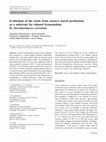
Annals of Microbiology
Cassava starch production waste (cassava pulp) has been proposed as a high potential ethanolic fe... more Cassava starch production waste (cassava pulp) has been proposed as a high potential ethanolic fermentation substrate due to its high residual starch level and the small particle size of the lignocellulosic fibers. Saccharification of the residual starch from a 3% (w/v) dry weight basis (DS) of cassava pulp by α-amylase (100°C, 10 min) and glucoamylase (60°C, 2 h) resulted in a glucose yield of 22.6 g/l [67.8% (w/w) DS of cassava pulp] and in lignocellulosic fibers at 0.5 g/g DS cassava pulp. Pretreatment of the lignocellulosic fiber with dilute sulfuric acid and calcium hydroxide at 121°C, 15 lb/in2 for 30 min increased and decreased, respectively, its susceptibility to cellulase hydrolysis. Under the optimal conditions found, pretreatment of 6% (w/v) DS lignocellulosic fiber by 2% (w/v) H2SO4 for 30 min, followed by saccharification by cellulase (40°C, 9 h), yielded a glucose level of 26.6 g/l [79.8% (w/w) DS of the cassava pulp]. The starch and lignocellulosic fiber hydrolysates obtained from 30 g cassava pulp and 60 g H2SO4 pretreated lignocellulosic fiber were fermented by Saccharomyces cerevisiae, without the need for (NH4)2SO4 supplementation, to yield ethanol levels of 9.9 and 11.9 g/l, respectively, after 48 h.
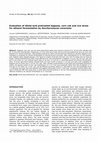
Annals of Microbiology, 2008
Bagasse, corn cob, and rice straw agricultural wastes were found to consist of 37, 39 and 34% cel... more Bagasse, corn cob, and rice straw agricultural wastes were found to consist of 37, 39 and 34% cellulose and 24, 41 and 22% hemicellulose, respectively, on a dry solid (w/w) basis and thus have the potential to serve as a low cost foodstock for ethanol production. Hydrolysates produced by dilute-acid pretreatment followed by cellulase digestion were evaluated as substrates for ethanol fermentation bySaccharomyces cerevisiae. After pretreatment by 141 mM sulphuric acid, bagasse waste released glucose (134 mg/g) at a higher level than that from corn cob (75 mg/g) and rice straw (8 mg/g). Hydroxymethylfurfural (HMF) levels derived from acid pretreatment of bagasse (1.5 g/l), but not corn cob (0.8 g/l) or rice straw (0.1 g/l) attained levels likely to be toxic (1.5 g/l) forS. cerevisiae growth and ethanol fermentation rates. All three agricultural wastes released likely non-toxic levels of furfural (<0.5 g/l) and lactic acid (negligible for bagasse and rice straw and 0.7 g/l for corn cob). After cellulase saccharification of the dilute-acid pretreated agricultural wastes, the glucose content of corn cob hydrolysates (13 ± 0.17 g/l) was marginally higher than that of bagasse (12 ±0.27 g/l) or rice straw (11 ± 0.07 g/l), yet the ethanol conversion yield byS. cerevisiae on corn cob hydrolysate (0.45 ± 0.006 g/g) was lower than that attained with bagasse hydrolysate (0.49 ± 0.007 g/g). Synergistic adverse effects between furfural and HMF with weak acids, or other lignin derived products in the corn cob hydrolysate are proposed as the effective inhibitor (s) for ethanol fermentation byS. cerevisiae.
International Journal of Systematic and Evolutionary Microbiology, 2009

International Journal of Systematic and Evolutionary Microbiology, 2010
A xylan-degrading bacterium, strain X11-1(T), was isolated from soil collected in Nan province, T... more A xylan-degrading bacterium, strain X11-1(T), was isolated from soil collected in Nan province, Thailand. The strain was characterized based on its phenotypic and genotypic characteristics. Strain X11-1(T) was a Gram-stain-positive, facultatively anaerobic, spore-forming, rod-shaped bacterium. It contained meso-diaminopimelic acid in the cell-wall peptidoglycan. The major menaquinone was MK-7, anteiso-C(15 : 0) (56.6 %) and C(16 : 0) (14.0 %) were the predominant cellular fatty acids and diphosphatidylglycerol, phosphatidylmonomethylethanolamine, phosphatidylethanolamine and phosphatidylglycerol were the major phospholipids. The DNA G+C content was 51.6 mol%. Phylogenetic analysis using 16S rRNA gene sequences showed that strain X11-1(T) was affiliated to the genus Paenibacillus and was closely related to Paenibacillus naphthalenovorans KACC 11505(T) and Paenibacillus validus CCM 3894(T), with 96.5 % sequence similarity. Therefore, the strain represents a novel species of the genus Paenibacillus, for which the name Paenibacillus xylanisolvens sp. nov. is proposed. The type strain is X11-1(T) (=KCTC 13042(T) =PCU 311(T) =TISTR 1829(T)).
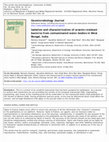
Annals of Microbiology, 2009
Highly arsenic resistant bacteria (27 isolates), which had a minimum inhibitory concentrations (M... more Highly arsenic resistant bacteria (27 isolates), which had a minimum inhibitory concentrations (MICs) for arsenite and arsenate of ⩾ 40 mM and > 400 mM, respectively, were isolated from tannery wastes and agricultural soils collected in Central Thailand. On the basis of the morphological, cultural, physiological and biochemical characteristics, and on the principal ubiquinone component and 16S rRNA gene sequence analyses, they were identified as nine isolates each ofKlebsiella (Groups 1 and 8) andAcinetobacter (Groups 2, 3 and 7), four isolates each ofPseudomonas (Groups 4 and 6) andComamonas (Group 5), and one isolate ofEnterobacter (Group 9). From these 27 isolates, only one isolate, A3-3 from the genusComamonas, appeared potentially capable of oxidizing arsenite to arsenate, as determined by silver nitrate staining of arsenite agar plates after colony growth.
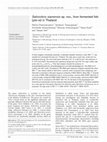
International Journal of Systematic and Evolutionary Microbiology, 2009
A Gram-negative, facultatively anaerobic, moderately halophilic bacterium, strain ND1-1 T , was i... more A Gram-negative, facultatively anaerobic, moderately halophilic bacterium, strain ND1-1 T , was isolated from fermented fish (pla-ra) in Thailand. The cells were curved rods, motile and nonendospore-forming. The novel strain grew optimally at 37 6C, at pH 8 and in the presence of 9"10 % (w/v) NaCl. The predominant respiratory lipoquinone was Q-8. The major cellular fatty acids were C 16 : 0 and C 12 : 0 . Polar lipid analysis revealed the presence of phosphatidylethanolamine, phosphatidylglycerol and diphosphatidylglycerol. The DNA G+C content was 49.0 mol%. Comparative 16S rRNA gene sequence analyses indicated that strain ND1-1 T was closely related to Salinivibrio costicola, which comprises three subspecies, and Salinivibrio proteolyticus with gene sequence similarities of 98.3-98.6 %. Strain ND1-1 T showed low levels of DNA-DNA relatedness with S. costicola subsp. costicola JCM 15095 T (33.2 %), S. costicola subsp. alcaliphilus DSM 16359 T (38.4 %), S. costicola subsp. vallismortis JCM 15096 T (59.7 %), and S. proteolyticus AF-2004 T (42.1 %). On the basis of the physiological and biochemical characteristics and the molecular data presented, strain ND1-1 T should be classified as a novel species of the genus Salinivibrio for which the name Salinivibrio siamensis sp. nov. is proposed. The type strain is ND1-1 T (5JCM 14472 T 5PCU 301 T 5TISTR 1810 T ).
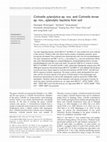
International Journal of Systematic and Evolutionary Microbiology, 2010
Two xylan-degrading bacteria, strains MX15-2 T and MX21-2 T , were isolated from soils collected ... more Two xylan-degrading bacteria, strains MX15-2 T and MX21-2 T , were isolated from soils collected in Nan province, Thailand. Cells were Gram-reaction-positive, facultatively anaerobic, sporeforming and rod-shaped. They contained meso-diaminopimelic acid in the cell-wall peptidoglycan. The major menaquinone was MK-7. iso-C 16 : 0 and anteiso-C 15 : 0 were the predominant cellular fatty acids. Diphosphatidylglycerol, phosphatidylglycerol, phosphatidylethanolamine and lysylphosphatidylglycerol were the major polar lipids. The genomic DNA G+C contents of strains MX15-2 T and MX21-2 T were 63.0 and 65.1 mol%, respectively. Phylogenetic analysis using 16S rRNA gene sequences showed that strains MX15-2 T and MX21-2 T were affiliated with the genus Cohnella and were closely related to Cohnella thermotolerans CCUG 47242 T , with 96.5 and 95.6 % sequence similarity, respectively. The strains could be clearly distinguished from each other and from all known species of the genus Cohnella based on their physiological and biochemical characteristics as well as their phylogenetic positions and levels of DNA-DNA hybridization. Therefore, these two strains represent novel species of the genus Cohnella, for which the names Cohnella xylanilytica sp. nov. (type strain MX15-2 T 5KCTC 22294 T 5PCU 309 T 5TISTR 1891 T ) and Cohnella terrae sp. nov. (type strain MX21-2 T 5KCTC 22295 T 5PCU 310 T 5TISTR 1892 T ) are proposed.
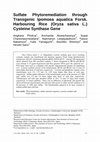
Rice (Oryza sativa L. cv Nipponbare) cysteine synthase gene (rcs1) encoding cytosolic isoform was... more Rice (Oryza sativa L. cv Nipponbare) cysteine synthase gene (rcs1) encoding cytosolic isoform was transformed into Ipomoea aquatica Forsk. using Agrobacterium tumefaciens EHA101 harbouring plasmid pBIH1-IG(SX)-RCS1. Among 240 regenerated shoots obtained from 908 cotyledon explants, 2 shoots designated as IRCS2 and IRCS4 were tolerant to 25 µg/ml hygromycin and their genomic DNAs gave the expected rcs1-PCR band when used as a template with specific oligonucleotide primers for amplifying rcs1. Cysteine synthase activity of the transformants, IRCS2 and IRCS4, was 3.4 and 3.0 times higher than those of wild type, respectively. Cysteine and glutathione contents of the transformants were 3.4, 1.75 and 2.4, 2.89 times higher than those of wild type, respectively. Sulfate uptake efficiency of the transformants, grown in the presence of 1,000 mg/l sulfate was 2.8 and 2.0 times higher than those of wild type, respectively. Transformants and wild type absorbed sulfate at 10.6, 7.6 and 3.8 mg/g fresh weight, respectively, in tested condition. There was no difference of phenotype and growth rate observed between transformants and wild type when grown in either normal condition or in the presence of 1,000 mg/l sulfate. The transformants appeared to be more resistant to sodium sulfide than wild type.

World Journal of Microbiology & Biotechnology, 2008
Two hundred and eighty-eight arsenic-resistant bacteria were isolated by an enrichment culture me... more Two hundred and eighty-eight arsenic-resistant bacteria were isolated by an enrichment culture method from a total of 69 arsenic-contaminated soil-samples collected from Dantchaeng district in Suphanburi province (47 samples), and from Ron Phiboon district in Nakhon Sri Thammarat province (22 samples), in Central and Southern Thailand, respectively. Twenty-four of the 288 isolated arsenic-resistant bacteria were found to be arsenite-oxidizing bacteria. On the basis of their morphological, cultural, physiological, biochemical and chemotaxonomic characteristics, and supported by phylogenetic analysis based upon their 16S rRNA gene sequences, they were divided into five groups, within the genera Acinetobacter, Flavobacterium, Pseudomonas, Sinorhizobium and Sphingomonas, respectively. Within genera, phylogenetic analysis using the 16S rRNA gene sequences suggested that they were comprised of at least ten species, five isolates being closely related to known bacteria (Acinetobacter calcoaceticus NCCB 22016T, Pseudomonas plecoglossicida FPC951T, Ps. knackmussii B13T, Sinorhizobium morelense Lc04T, and Sphingomonas subterranea IFO16086T). The other five proposed species are likely to be new species closely related to Flavobacterium johnsoniae, Sinorhizobium morelense, Acinetobacter calcoaceticus and Pseudomonas plecoglossicida, but this awaits further characterization for confirmation of the taxonomic status. No overlap in isolated species or strains was observed between the two sites. The strain distribution and characterization are described.
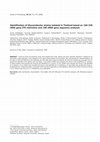
Annals of Microbiology, 2008
Forty-five acetic acid bacteria, which were isolated from fruits, flowers and other materials col... more Forty-five acetic acid bacteria, which were isolated from fruits, flowers and other materials collected in Thailand by an enrichment culture approach, were assigned to the genusGluconobacter by phenotypic and chemotaxonomic characterisations. On the basis of 16S–23S rRNA gene ITS restriction and 16S rRNA gene sequence analyses, the forty-five isolates were grouped into five groups and identified at the specific level as follows: 1) seventeen isolates were grouped into Group A and identified asG. oxydans; 2) twelve isolates were grouped into Group B and identified asG. cerinus; 3) nine isolates were grouped into Group C and identified asG. frateurii; 4) six isolates were included into Group D and identified asG. thailandicus; 5) one isolate was grouped into Group E, characterised by a restriction pattern comprised of 667 and 48-bp fragments inAvaII digestion, differing from those of strains of Group C orG. frateurii and Group D orG. thailandicus, and unidentified.
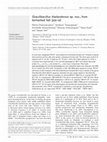
International Journal of Systematic and Evolutionary Microbiology, 2010
A novel strain, designated TP2-8 T , was isolated from fermented fish (pla-ra) in Thailand. It st... more A novel strain, designated TP2-8 T , was isolated from fermented fish (pla-ra) in Thailand. It stained Gram-positive and the cells were aerobic, endospore-forming rods. The strain grew at pH 6-8 (optimum pH 7), 15-55 6C (optimum 37 6C) and 1-22 % (w/v) NaCl (optimum 5-10 %). It contained meso-diaminopimelic in the cell-wall peptidoglycan. MK-7 and cellular fatty acids anteiso-C 15 : 0 , iso-C 15 : 0 and anteiso-C 17 : 0 were major components. Polar lipids diphosphatidylglycerol and phosphatidylglycerol and unidentified lipids were detected. The DNA G+C content was 37.6 mol%. Comparison of the 16S rRNA gene sequence of strain TP2-8 T with those of other members of the family Bacillaceae indicated that it was a member of the genus Gracilibacillus (94.9-99.2 % sequence similarity) and was closely related to Gracilibacillus saliphilus YIM 91119 T (99.2 % similarity), G. lacisalsi BH312 T (98.6 %), G. orientalis XH-63 T (97.7 %), 'G. quinghaiensis' YIM C229 (97.7 %) and G. boraciitolerans T-16X T (97.2 %). Strain TP2-8 T showed low DNA-DNA relatedness (¡49 %) to G. saliphilus YIM 91119 T , G. lacisalsi DSM 19029 T , G. orientalis CCM 7326 T , 'G. quinghaiensis' DSM 17858 and G. boraciitolerans JCM 21714 T . On the basis of the physiological and biochemical characteristics and molecular data presented, strain TP2-8 T is proposed to represent a novel species, Gracilibacillus thailandensis sp. nov. (type strain TP2-8 T 5JCM 15569 T 5PCU 304 T 5TISTR 1881 T ).
Annals of Microbiology, 2008
Ninety-seven acetic acid bacteria, which were isolated from fruits, flowers and other material co... more Ninety-seven acetic acid bacteria, which were isolated from fruits, flowers and other material collected in Thailand by an enrichment culture approach, were assigned to the genusAcetobacter by phenotypic and chemotaxonomic characterisations. On the basis of 16S–23S rRNA gene ITS restriction and 16S rRNA gene sequence analyses, the ninety-seven isolates were grouped into three groups and identified at the specific level: 1) group A including fifty-three isolates, which were identified asAcetobacter pasteurianus, 2) group B including forty-two isolates, which were identified asAcetobacter orientalis and 3) group C including two isolates, which were identified asAcetobacter lovaniensis. There was no isolate to be assigned to other 15 species of the genusAcetobacter.
Journal of General and Applied Microbiology, 2007

Journal of Food Biochemistry, 2008
ABSTRACTA halophilic proteolytic bacterium, NB2-1, isolated from Pla-ra, fermented fish in Thaila... more ABSTRACTA halophilic proteolytic bacterium, NB2-1, isolated from Pla-ra, fermented fish in Thailand, was identified as Virgibacillus marismortui on the basis of the genetic and phenotypic characteristics. NB2-1 produced a substantial level of extracellular proteolytic activity, corresponding with the growth and reaching the maximum at the end of the exponential phase (3 days). The optimum conditions required for maximum protease production were 15% (w/v) NaCl, pH at 9 and temperature at 30C. Of the media tested, maximum protease production occurred in a medium containing 15% NaCl, 0.5% yeast extract, 0.1% glutamic acid, 0.2% KCl, 0.3% trisodium citrate, 2% MgSO4·7H2O, 0.0036% FeCl2·4H2O and 0.000036% MnCl2·4H2O. The protease activity was optimally active at pH 10, 50C and 5% (w/v) NaCl when casein was used as a substrate. The activity was strongly inhibited by phenylmethane sulfonyl fluoride. Activity-stained substrate gel indicated the presence of several proteases with the estimated molecular weights of 17, 19, 24, 29 and 35 kDa in the crude NB2-1 extracellular protease. The results of the present investigation showed that the strain NB2-1 could be a potential source of thermoactive alkaline protease production.A halophilic proteolytic bacterium, NB2-1, isolated from Pla-ra, fermented fish in Thailand, was identified as Virgibacillus marismortui on the basis of the genetic and phenotypic characteristics. NB2-1 produced a substantial level of extracellular proteolytic activity, corresponding with the growth and reaching the maximum at the end of the exponential phase (3 days). The optimum conditions required for maximum protease production were 15% (w/v) NaCl, pH at 9 and temperature at 30C. Of the media tested, maximum protease production occurred in a medium containing 15% NaCl, 0.5% yeast extract, 0.1% glutamic acid, 0.2% KCl, 0.3% trisodium citrate, 2% MgSO4·7H2O, 0.0036% FeCl2·4H2O and 0.000036% MnCl2·4H2O. The protease activity was optimally active at pH 10, 50C and 5% (w/v) NaCl when casein was used as a substrate. The activity was strongly inhibited by phenylmethane sulfonyl fluoride. Activity-stained substrate gel indicated the presence of several proteases with the estimated molecular weights of 17, 19, 24, 29 and 35 kDa in the crude NB2-1 extracellular protease. The results of the present investigation showed that the strain NB2-1 could be a potential source of thermoactive alkaline protease production.PRACTICAL APPLICATIONSHalophiles are the most likely source of enzymes that not only are salt-tolerant but also thermotolerant. They constitute a heterogeneous group of microorganisms including species belonging to different genera. The isolation of halophiles able to produce extracellular enzymes will provide the possibility to have optimal activities at different salt concentrations. Virgibacillus marismortui NB2-1, a moderately halophilic bacterium isolated from Pla-ra, produced a substantial level of extracellular proteolytic activity that was active in extreme conditions. Using casein as a substrate, the protease exhibited maximal activity at pH 10, 50C in the presence of 5% (w/v) NaCl. The results of the present investigation showed that the strain NB2-1 could be a potential source of thermoactive alkaline protease production.Halophiles are the most likely source of enzymes that not only are salt-tolerant but also thermotolerant. They constitute a heterogeneous group of microorganisms including species belonging to different genera. The isolation of halophiles able to produce extracellular enzymes will provide the possibility to have optimal activities at different salt concentrations. Virgibacillus marismortui NB2-1, a moderately halophilic bacterium isolated from Pla-ra, produced a substantial level of extracellular proteolytic activity that was active in extreme conditions. Using casein as a substrate, the protease exhibited maximal activity at pH 10, 50C in the presence of 5% (w/v) NaCl. The results of the present investigation showed that the strain NB2-1 could be a potential source of thermoactive alkaline protease production.

International Journal of Systematic and Evolutionary Microbiology, 2009
Two strains of xylanase-producing bacteria, S3-4A(T) and MX2-3(T), isolated from soils in Thailan... more Two strains of xylanase-producing bacteria, S3-4A(T) and MX2-3(T), isolated from soils in Thailand, were characterized on the basis of their phenotypic and chemotaxonomic characteristics, DNA-DNA relatedness and 16S rRNA gene sequences. The novel strains were Gram-positive, facultatively anaerobic, spore-forming, rod-shaped bacteria. They contained meso-diaminopimelic acid as the diagnostic diamino acid in the cell-wall peptidoglycan. The DNA G+C contents of strains S3-4A(T) and MX2-3(T) were 52.7 and 52.9 mol%, respectively. The major isoprenoid quinone was MK-7. The dominant cellular fatty acids were anteiso-C(15 : 0) and iso-C(16 : 0). Phylogenetic analyses using 16S rRNA gene sequences showed that both novel strains were affiliated to the genus Paenibacillus. Strains S3-4A(T) and MX2-3(T) were closely related to Paenibacillus agaridevorans DSM 1355(T) with 97 % and 97.3 % gene sequence similarities, respectively. The DNA-DNA relatedness between strains S3-4A(T), MX2-3(T) and P. agaridevorans DSM 1355(T) was low (6.0-30.3 %). The novel strains could be clearly distinguished from P. agaridevorans DSM 1355(T) by physiological and biochemical characteristics. Therefore, these two strains represent novel species of the genus Paenibacillus, for which the names Paenibacillus thailandensis sp. nov. (type strain S3-4A(T)=KCTC 13043(T)=PCU 275(T)=TISTR 1827(T)) and Paenibacillus nanensis sp. nov. (type strain MX2-3(T)=KCTC 13044(T)=PCU 276(T)=TISTR 1828(T)) are proposed.





Uploads
Papers by Ancharida Akaracharanya